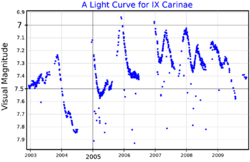IX Carinae
Topic: Astronomy
 From HandWiki - Reading time: 4 min
From HandWiki - Reading time: 4 min
| Observation data Equinox J2000.0]] (ICRS) | |
|---|---|
| Constellation | Carina |
| Right ascension | 10h 50m 26.300s[2] |
| Declination | 59° 58′ 56.57″[2] |
| Apparent magnitude (V) | 7.2 - 8.5[3] or 6.87 - 7.9[4] |
| Characteristics | |
| Spectral type | M2Iab[3] |
| Variable type | SRc[3][4] |
| Astrometry | |
| Radial velocity (Rv) | 0.90±1.8[5] km/s |
| Proper motion (μ) | RA: –6.466[2] mas/yr Dec.: 2.322[2] mas/yr |
| Parallax (π) | 0.4436 ± 0.0220[2] mas |
| Distance | 7,400 ± 400 ly (2,300 ± 100 pc) |
| Details | |
| Mass | 13[6] M☉ |
| Radius | 566[7] R☉ |
| Luminosity | 52,000[7] L☉ |
| Temperature | 3,660±170[7] K |
| Other designations | |
IX Car, CD-59°3368, CPD-59°2775, GSC 08626-01670, HD 94096, HIP 52991, IRAS 10484-5943, 2MASS J10502630-5958563, PPM 339497, SAO 238523, TYC 8626-1670-1 | |
| Database references | |
| SIMBAD | data |
IX Carinae (IX Car) is a red supergiant and pulsating variable star of spectral type M2Iab in the constellation Carina. It is a member of the Carina OB1 association along the Carina Nebula.
IX Carinae is a semiregular variable star, but its properties are poorly-defined. Different sources give its brightness range as magnitude 7.2 to 8.5.[3] or 6.87 to 7.9.[4] The International Variable Star Index finds a period of approximately 384 days from ASAS-3 and visual observations, but also gives a possible period of 108 days.[4] Another analysis finds a primary period of 408±50 d and a longer secondary period of 4,400±2,000 d.[8][3]
The physical characteristics of IX Carinae are also only known approximately, partly because of an uncertain distance. The effective temperature is around 3,600 K,[9][7] while its bolometric luminosity is between 34,000 L☉[10] and 134,000 L☉.[9] It is one of the largest stars with a radius of approximately 566 R☉ (394,000,000 km; 2.63 astronomical unit|au).[7] If placed at the center of the Solar System, it would extend close to the orbit of the outer Asteroid Belt Jupiter.
IX Carinae has been listed as a candidate supernova close enough to Earth that pre-collapse neutrinos could be detected, allowing for observations of the star to be made from before the supernova explosion.[11]
References
- ↑ "ASAS All Star Catalogue". The All Sky Automated Survey. http://www.astrouw.edu.pl/asas/?page=aasc.
- ↑ 2.0 2.1 2.2 2.3 2.4 Vallenari, A. et al. (2022). "Gaia Data Release 3. Summary of the content and survey properties". Astronomy & Astrophysics. doi:10.1051/0004-6361/202243940 Gaia DR3 record for this source at VizieR.
- ↑ 3.0 3.1 3.2 3.3 3.4 "GCVS Query=IX Car". General Catalogue of Variable Stars @ Sternberg Astronomical Institute, Moscow, Russia. http://www.sai.msu.su/gcvs/cgi-bin/search.cgi?search=IX+Car.
- ↑ 4.0 4.1 4.2 4.3 "IX Carinae". AAVSO. https://www.aavso.org/vsx/index.php?view=detail.top&oid=5994.
- ↑ Gontcharov, G. A.; Massey, Philip; Olsen, K. A. G.; Plez, Bertrand; Josselin, Eric; Maeder, Andre; Meynet, Georges (2006). "Pulkovo Compilation of Radial Velocities for 35 495 Hipparcos stars in a common system". Astronomy Letters 32 (11): 759–771. doi:10.1134/S1063773706110065. Bibcode: 2006AstL...32..759G.
- ↑ Kervella, Pierre; Arenou, Frédéric; Thévenin, Frédéric (2022). "Stellar and substellar companions from Gaia EDR3". Astronomy & Astrophysics 657: A7. doi:10.1051/0004-6361/202142146. Bibcode: 2022A&A...657A...7K.
- ↑ 7.0 7.1 7.2 7.3 7.4 Messineo, M.; Brown, A. G. A. (2019). "A Catalog of Known Galactic K-M Stars of Class I Candidate Red Supergiants in Gaia DR2". The Astronomical Journal 158 (1): 20. doi:10.3847/1538-3881/ab1cbd. Bibcode: 2019AJ....158...20M.
- ↑ Percy, John R.; Sato, Hiromitsu (2009). "Long Secondary Periods in Pulsating Red Supergiant Stars". Journal of the Royal Astronomical Society of Canada 103 (1): 11. Bibcode: 2009JRASC.103...11P.
- ↑ 9.0 9.1 Dorn-Wallenstein, Trevor Z.; Levesque, Emily M.; Neugent, Kathryn F.; Davenport, James R. A.; Morris, Brett M.; Gootkin, Keyan (2020). "Short Term Variability of Evolved Massive Stars with TESS II: A New Class of Cool, Pulsating Supergiants". The Astrophysical Journal 902 (1): 24. doi:10.3847/1538-4357/abb318. Bibcode: 2020ApJ...902...24D.
- ↑ Brown, A. G. A. (August 2018). "Gaia Data Release 2: Summary of the contents and survey properties". Astronomy & Astrophysics 616: A1. doi:10.1051/0004-6361/201833051. Bibcode: 2018A&A...616A...1G. Gaia DR2 record for this source at VizieR.
- ↑ Nakamura, Ko; Horiuchi, Shunsaku; Tanaka, Masaomi; Hayama, Kazuhiro; Takiwaki, Tomoya; Kotake, Kei (2016). "Multimessenger signals of long-term core-collapse supernova simulations: Synergetic observation strategies". Monthly Notices of the Royal Astronomical Society 461 (3): 3296. doi:10.1093/mnras/stw1453. Bibcode: 2016MNRAS.461.3296N.
 |
 KSF
KSF
